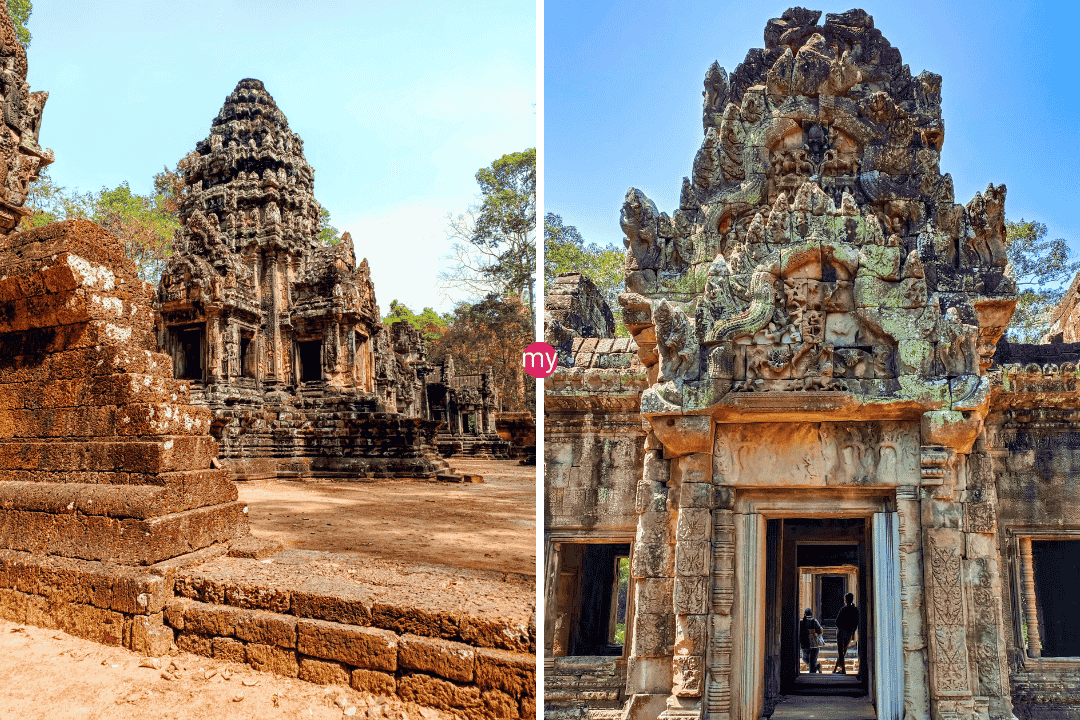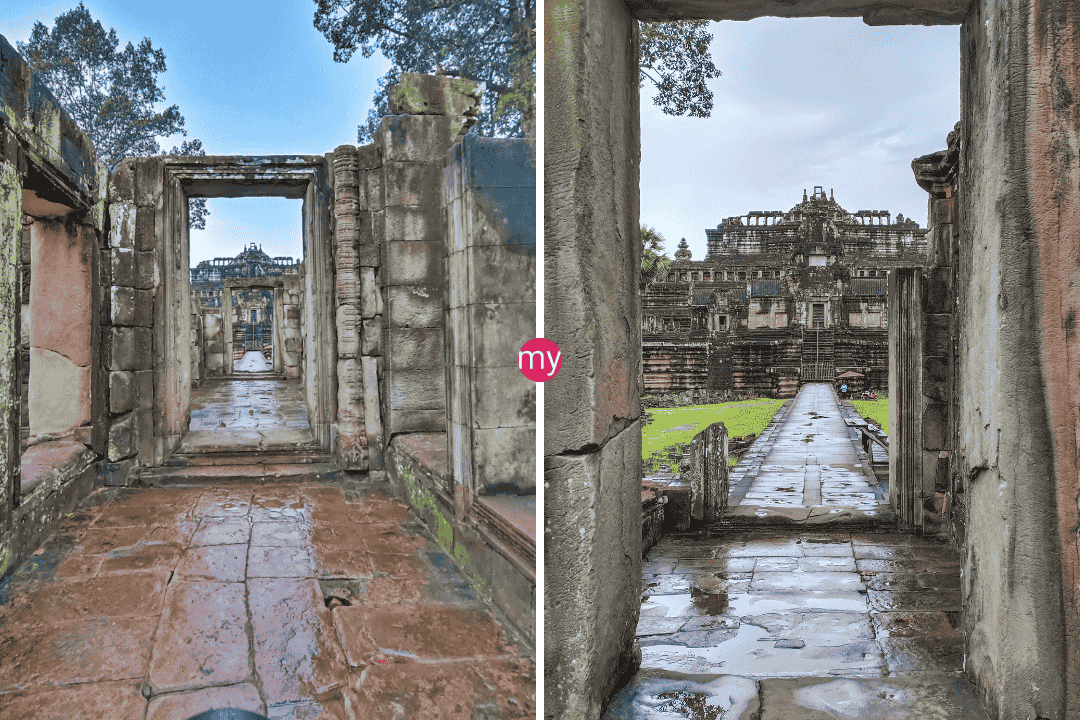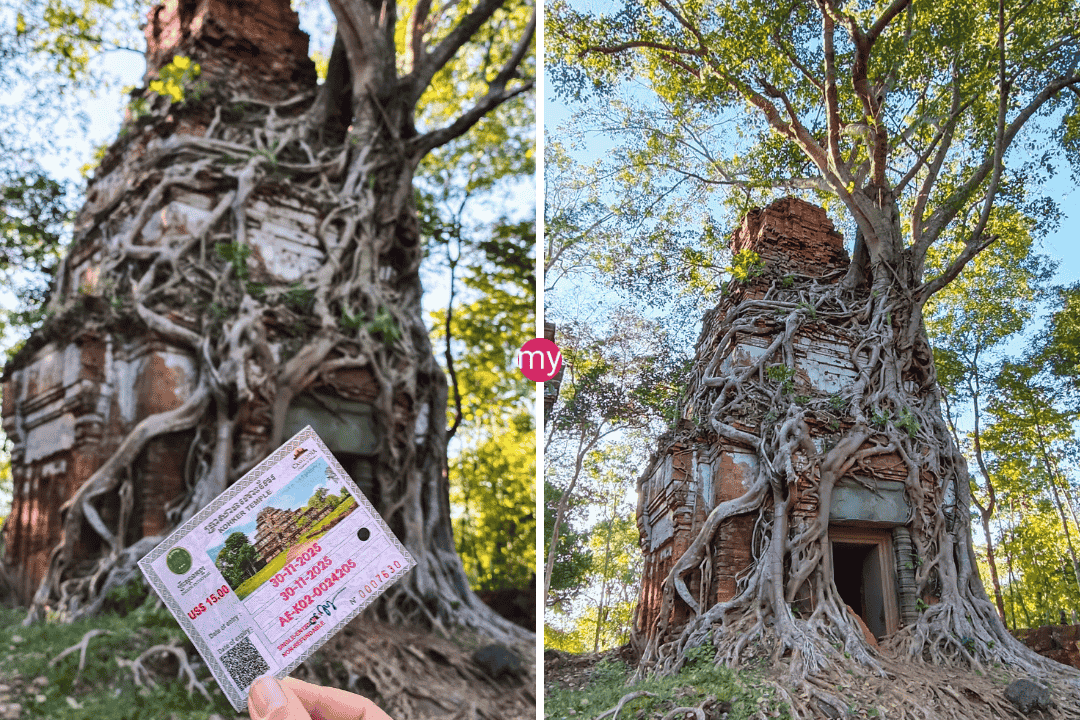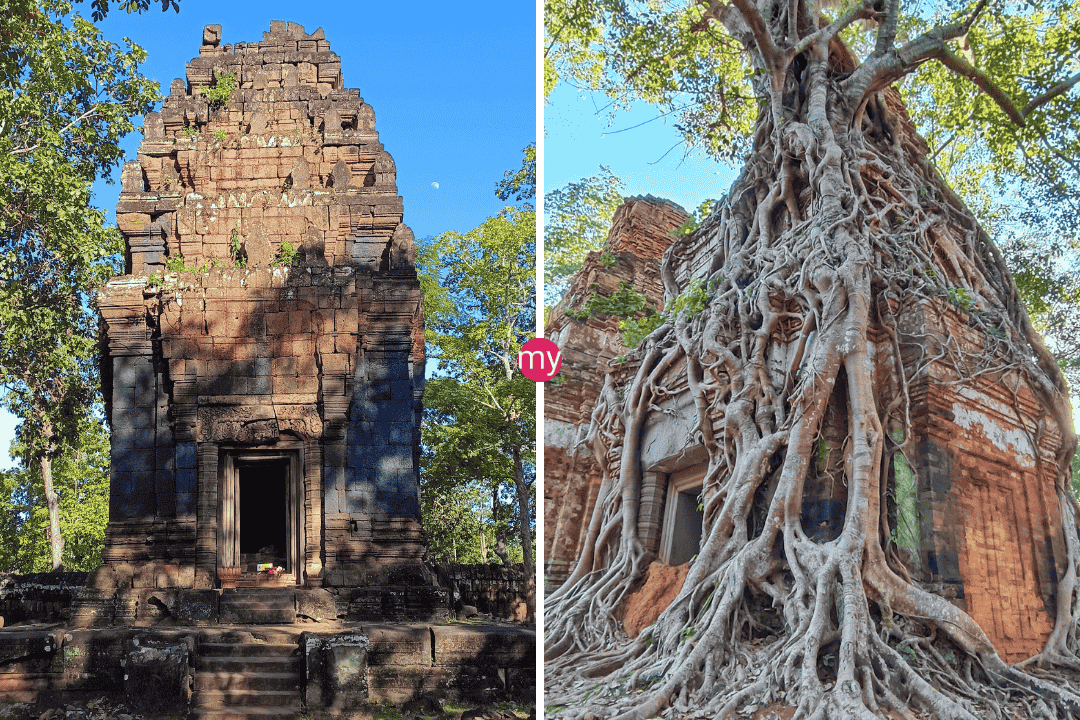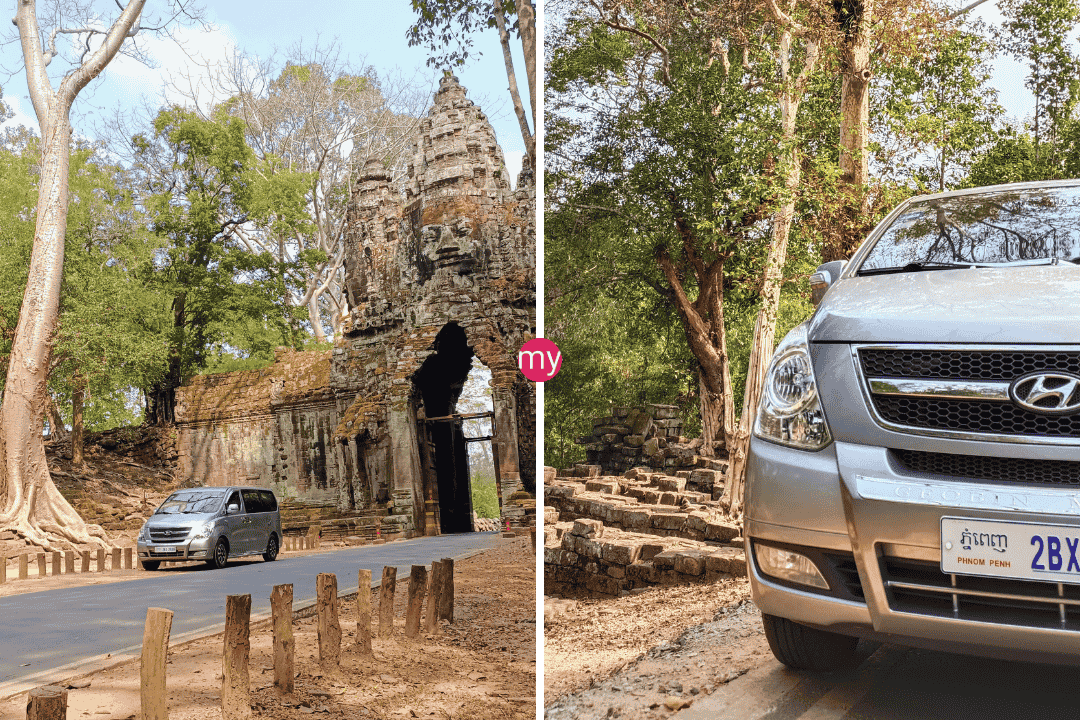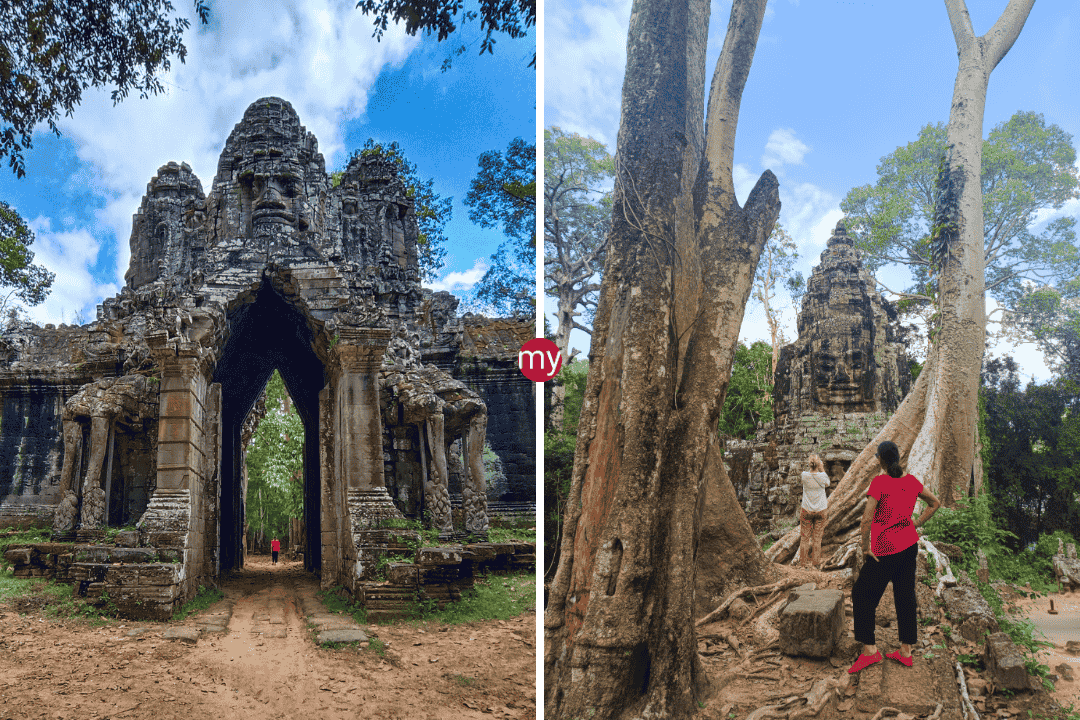Unraveling the Historical Significance of Angkor Thom: A Deep Dive into Baphuon and Bayon Temples
Welcome, intrepid travelers and history enthusiasts! Today, we’re taking you on a journey through time to explore the mysterious wonders of Cambodia’s ancient capital, Angkor Thom. We’ll be focusing on two of its most iconic temples, Baphuon and Bayon, and uncovering their historical significance. So, buckle up and let’s get started!
Baphuon Temple: The Mountain of Kailasa
Baphuon, a temple dating back to the 11th century, is known as the “Mountain of Kailasa” and is a testament to the architectural prowess of the Khmer Empire. Let’s dive deeper into what makes Baphuon so captivating:
- Architectural Marvel: This three-tiered temple was constructed to represent Mount Meru, the mythical home of the gods in Hindu mythology. Its intricate carvings and reliefs showcase the empire’s artistic mastery.
- The Reclining Buddha: In the 16th century, Baphuon was converted into a Buddhist temple, and an enormous reclining Buddha was added to its western side, symbolizing the transition from Hinduism to Buddhism in Cambodia.
- A Restoration Masterpiece: Baphuon underwent a 16-year restoration project, bringing this once-crumbling temple back to its former glory.
Want to experience the magic of Baphuon Temple for yourself? Then, check out our Private Angkor Wat 2-Day Tour for an unforgettable adventure.
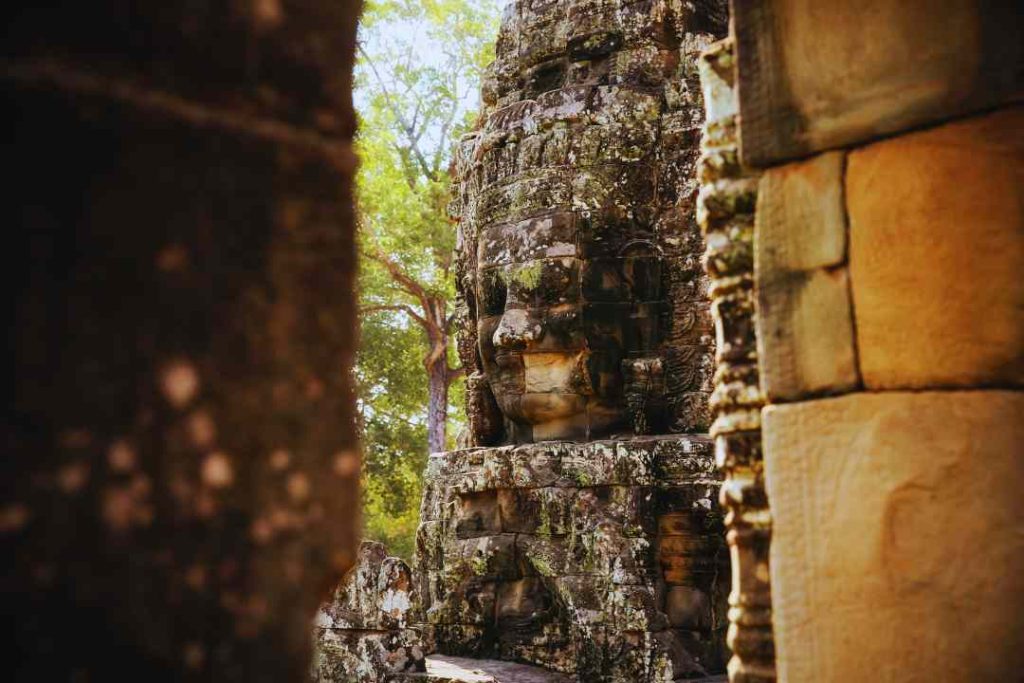
Bayon Temple: The Face of Serenity
Bayon Temple, the enigmatic centerpiece of Angkor Thom, is renowned for its giant stone faces. Let’s explore some highlights of this awe-inspiring temple:
- The Faces of Bayon: With over 200 enormous stone faces adorning its towers, Bayon leaves visitors spellbound. These faces are believed to represent King Jayavarman VII, who built the temple, or the bodhisattva of compassion, Avalokiteshvara.
- A Symbol of Unity: Bayon Temple was constructed as a symbol of unity between Hinduism and Buddhism, showcasing religious influences in its architecture and carvings.
- Bas-Reliefs: Bayon’s intricate bas-reliefs offer a glimpse into the daily life, battles, and ceremonies of the Khmer Empire, providing a valuable historical record for researchers.
If you’re eager to see the enigmatic faces of Bayon Temple, join our Private Angkor Thom Half-Day Tour and experience the magic for yourself.
For the perfect mix of temples and photography, check out our Private Angkor Wat Mix Temples photo tour, which offers a unique blend of sightseeing and capturing stunning shots of these architectural marvels.
If you’re short on time but still want to experience the best of Angkor Wat, our 1-Day Angkor Wat Small Loop Private Tour is designed just for you. This tour covers the essential temples while providing fascinating insights into their history and significance.
Discovering the Magic of Angkor Thom Attractions
Imagine the sun rising behind ancient temples and overgrown tree roots, the smell of damp earth, and the distant sounds of exotic birds. This is the magical world of Angkor Thom, a city lost in time, waiting to be explored.
If you’re looking for a unique and unforgettable experience, you’ve come to the right place. In this guide, we’ll walk you through some of the most fascinating Angkor Thom attractions, and by the end, you’ll be eager to pack your bags and see them for yourself.
The Enigmatic Bayon Temple
As you enter the ancient city of Angkor Thom through the grand South Gate, you’ll be greeted by the enigmatic Bayon Temple. Known for its 216 massive stone faces that seem to watch your every move, this 12th-century temple is a masterpiece of Khmer architecture.
These captivating faces represent the bodhisattva of compassion, Avalokiteshvara, and the all-seeing eyes of the king.
As you stroll through the temple’s narrow corridors and steep staircases, make sure to admire the intricate bas-reliefs depicting scenes from everyday life and historical events. The storytelling nature of these carvings brings the ancient world of Angkor Thom to life before your eyes.
Bayon Temple Historical background
Bayon Temple was built in the late 12th to early 13th century by King Jayavarman VII, a ruler of the Khmer Empire. The temple served as the centerpiece of Angkor Thom, reflecting the king’s vision of a grand and harmonious city.
Architectural style
The temple exhibits a unique blend of architectural styles, combining elements of Buddhist and Hindu traditions. Its intricate bas-reliefs, towering stone faces, and an overall sense of grandiosity characterize the structure.
Unique Features of Bayon Temple – The Stone Faces
Perhaps the most iconic feature of Bayon Temple is the enigmatic stone faces that adorn its towers. There are more than 200 of these massive, smiling faces, each exuding serenity, and mystery. Scholars believe these faces represent the bodhisattva Avalokiteshvara, a compassionate being in Mahayana Buddhism, or perhaps even the king himself.
The Bas-reliefs – Depictions of historical events
The bas-reliefs that decorate the temple’s walls provide a fascinating insight into the history and culture of the Khmer Empire. They depict historical events, such as battles and naval expeditions, giving visitors a glimpse into the past.
Scenes from everyday life
In addition to the historical events, the bas-reliefs also portray scenes from daily life in the Khmer Empire. These images include farmers tending to their fields, fishermen casting their nets, and market scenes bustling with activity.
The Central Sanctuary
At the heart of Bayon Temple lies its central sanctuary, a sacred space that once housed a statue of the Buddha. This area is surrounded by a maze of galleries and passages, creating an enchanting and somewhat disorienting atmosphere for visitors to explore.
The Outer Galleries
The outer galleries of Bayon Temple contain even more bas-reliefs, some of which depict famous Hindu myths such as the Churning of the Sea of Milk and the Ramayana. These galleries serve as a testament to the religious syncretism of the Khmer Empire, which embraced both Buddhism and Hinduism.
Mysteries and Symbolism – The Meaning of the Faces
The enigmatic faces that grace the towers of Bayon Temple have long been a subject of debate among scholars. Some believe they represent King Jayavarman VII himself, embodying his divine authority and benevolence. Others argue that they symbolize the bodhisattva Avalokiteshvara, reflecting the temple’s Buddhist heritage.
The Purpose of the Temple
Bayon Temple served multiple purposes during the Khmer Empire. It was a state temple dedicated to the Buddha, a symbol of the king’s divine power, and a monument celebrating the empire’s achievements. However, the temple’s precise religious and political functions remain a subject of scholarly debate.
Religious Significance
The temple’s intricate design and iconography reflect the religious beliefs and practices of the Khmer Empire. Bayon Temple’s syncretic blend of Buddhist and Hindu elements is particularly noteworthy, as it demonstrates the empire’s religious tolerance and adaptability.
Threats to the Temple
Over the centuries, Bayon Temple has faced numerous threats, including natural disasters, looting, and neglect. In addition, the encroaching jungle and shifting soil have also posed significant challenges to the temple’s structural integrity.
UNESCO World Heritage Site
In recognition of its historical and cultural significance, Bayon Temple was inscribed on the UNESCO World Heritage List in 1992, along with the rest of the Angkor complex. This designation has helped to raise awareness and generate support for the temple’s preservation.
Bayon Temple Conservation Projects
Several organizations have undertaken restoration and conservation efforts at Bayon Temple, including the Japanese Government Team for Safeguarding Angkor (JSA) and the World Monuments Fund. These projects have focused on stabilizing the temple’s structure, restoring its bas-reliefs, and promoting sustainable tourism.
Visiting Bayon Temple
Hiring a knowledgeable local guide can greatly enhance your experience, as they can provide insights into the temple’s history and symbolism.
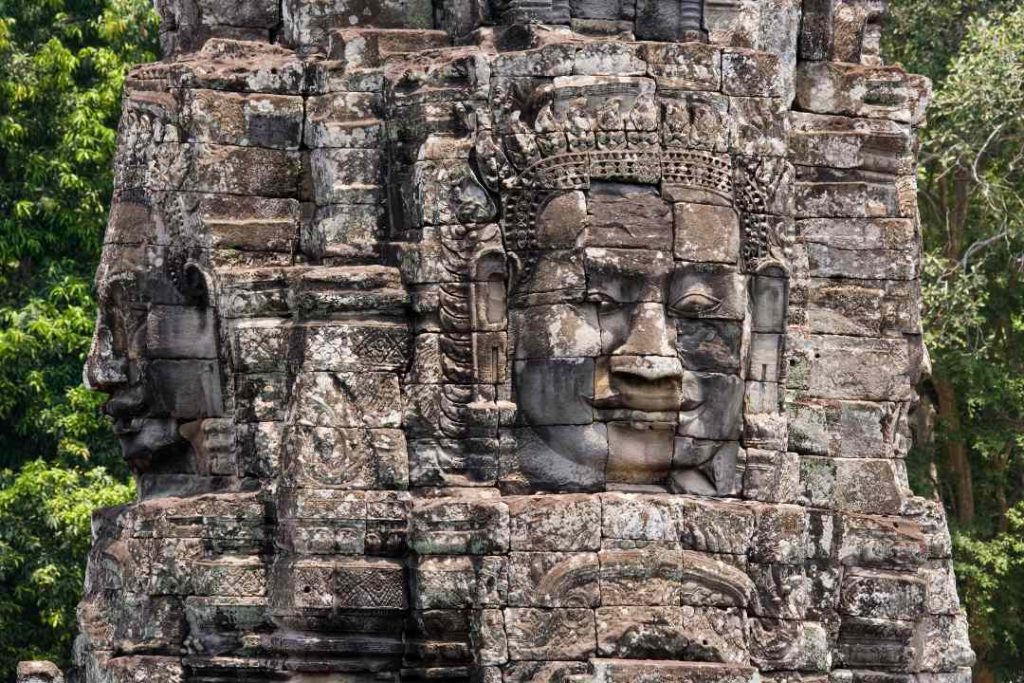
Baphuon Temple: The Towering Pyramid
Just a short walk from Bayon, you’ll find the impressive Baphuon Temple, a pyramid-shaped structure that is among the tallest monuments in the Angkor Thom complex. Built-in the 11th century, the state temple was once dedicated to the Hindu god Shiva.
Climbing the steep stairway to the top of this three-tiered temple, you’ll be rewarded with panoramic views of the surrounding area, making it an ideal spot for taking those breathtaking photos you’ll treasure forever. Be sure to take a moment and marvel at the 70-meter-long reclining Buddha, an awe-inspiring sight that adds to the temple’s mystique.
Baphuon Temple: An Architectural Marvel in the Heart of Angkor
Introduction to Baphuon Temple
Nestled in the heart of the ancient city of Angkor in Cambodia, the Baphuon Temple is a stunning architectural masterpiece that has stood the test of time. The temple, which was once known as the “Tower of Bronze,” has a rich history and intricate design that reflects the Khmer Empire’s architectural prowess. This article takes you on a journey through this remarkable temple’s fascinating history, architectural features, and significance.
The History of Baphuon Temple
Built during the 11th century, the Baphuon Temple was commissioned by the Khmer King Udayadityavarman II as a Hindu temple dedicated to the god Shiva. The temple’s design follows the architectural style of the Baphuon era, which was characterized by grand structures and intricate carvings. The three-tiered temple was once adorned with bronze plates, giving it the nickname “Tower of Bronze.”
Buddhist Conversion of the Baphuon Temple
During the 15th century, the temple underwent a significant transformation when it was converted into a Buddhist shrine. A giant reclining Buddha was constructed on the second tier, dramatically altering the temple’s original layout. This conversion marked a significant shift in the religious landscape of the region.
Discovery and Restoration
After centuries of abandonment and decay, the Baphuon Temple was rediscovered by French archaeologists in the early 20th century.
The temple’s restoration process began in the 1960s and continued through the 21st century, with support from the French government and UNESCO.
After decades of painstaking restoration work, the temple was finally reopened to the public in 2011.
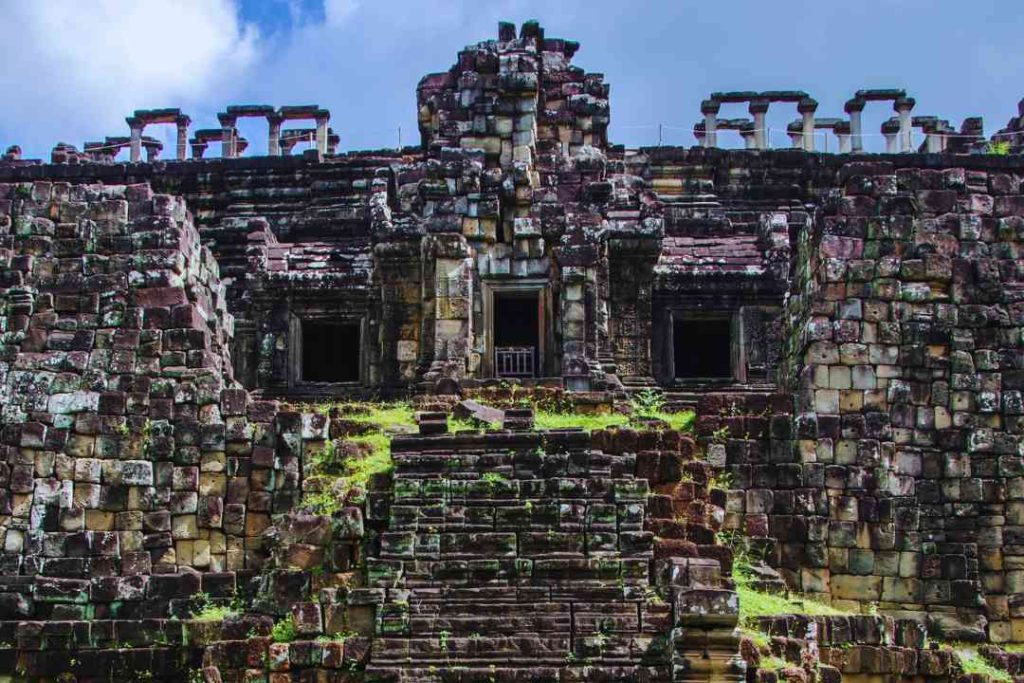
Baphuon Temple Architectural Features
Terraces and Causeways
Visitors to the Baphuon Temple are greeted by terraces and causeways leading to the main structure.
These elevated walkways are adorned with naga balustrades and stone lion statues, showcasing the meticulous craftsmanship of the Khmer builders.
Carvings and Sculptures
One of the most striking features of the Baphuon Temple is its intricate carvings and sculptures. The temple’s walls are adorned with scenes from Hindu mythology featuring gods and celestial beings. Among the most notable carvings are the “Churning of the Ocean of Milk” and depictions of the Hindu god Vishnu.
The Reclining Buddha
The second tier of the Baphuon Temple is home to an impressive 70-meter-long reclining Buddha, constructed during the temple’s conversion to Buddhism. Although the Buddha is now partially ruined, its sheer size and complexity remain awe-inspiring.
Exploring Baphuon Temple
The Baphuon Temple is situated just northwest of the famous Bayon Temple, making it an essential stop on any Angkor itinerary.
What to Expect visiting the Baphuon Temple
When visiting the Baphuon Temple, be prepared to climb several steep staircases to reach the upper levels. The temple offers breathtaking panoramic views of the surrounding area, making the climb well worth the effort. As with any religious site, visitors are advised to dress modestly, covering their shoulders and knees, to show respect for local customs.
The Significance of Baphuon Temple
The Baphuon Temple holds a special place in the history of the Khmer Empire, as it represents a time of great prosperity and artistic achievement. The temple’s intricate design, carvings, and sculptures are a testament to the skill and craftsmanship of the builders who constructed it. Additionally, the temple’s conversion from Hinduism to Buddhism reflects the religious evolution that took place within the empire.
The Royal Enclosure: A Glimpse into Royalty
Within the heart of Angkor Thom lies the Royal Enclosure, where the Khmer kings once ruled. While the wooden palace no longer stands, the surrounding monuments provide an insight into the lives of the elite.
Among these is the Phimeanakas Temple, a three-tiered pyramid structure that once housed the king’s personal shrine. It is said that the king would climb the temple each night to consult with a sacred serpent believed to protect the kingdom.
Another fascinating site within the Royal Enclosure is the Terrace of the Elephants, a 350-meter-long platform adorned with elephant statues and carvings. This terrace was once the stage for royal ceremonies, and as you stand on its steps, you can almost hear the echoes of the past.
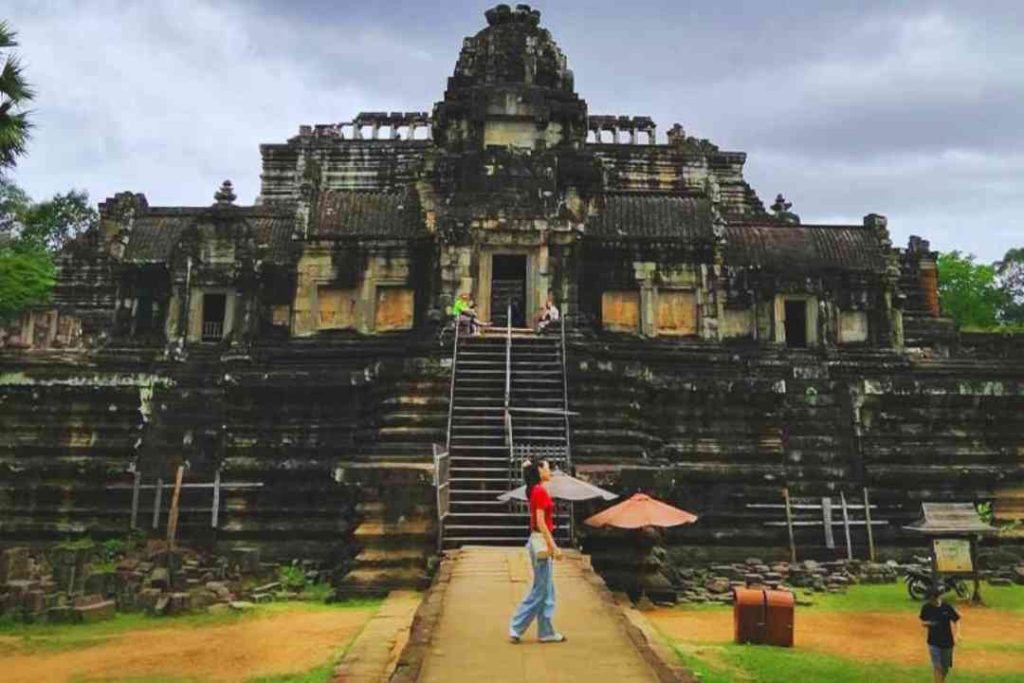
Preah Palilay: A Serene Sanctuary
Tucked away in a quiet corner of Angkor Thom, Preah Palilay offers a tranquil respite from the bustling crowds.
This small, 13th-century temple is surrounded by lush vegetation, creating a peaceful atmosphere that invites you to slow down and appreciate the beauty around you.
While the temple itself is modest in size, its elegant carvings and the serene environment make it a hidden gem worth discovering.
As you explore the temple grounds, listen for the sounds of birds and the gentle rustle of leaves, and allow yourself to be transported back in time.
Tips for Exploring Angkor Thom Attractions
Now that you’re ready to embark on your Angkor Thom adventure, here are a few tips to ensure you have the best experience possible:
- Dress appropriately: The temples are sacred sites, and visitors should dress modestly, covering their shoulders and knees.
- Stay hydrated: Cambodia can be hot and humid, so make sure to bring plenty of water and take breaks in the shade when needed.
- Hire a local guide: A knowledgeable guide can provide valuable insights into the history and significance of the temples, enhancing your experience.
- Capture the moment: Don’t forget to bring a camera or smartphone to capture the stunning sights and memories of your journey.
The Lasting Impact of Angkor Thom
The historical significance of Angkor Thom is multifaceted. Its temples, such as Baphuon and Bayon, not only showcase the artistic and architectural achievements of the Khmer Empire but also serve as a testament to the empire’s religious tolerance and unity.
The temples of Angkor Thom continue to inspire and captivate visitors from around the world, and their legacy endures as a source of national pride for Cambodia.
Ready to Discover the Wonders of Angkor Thom?
There’s no better way to experience the historical significance of Angkor Thom than with our top-notch private guided tours.
We pride ourselves on offering the most captivating and competitively-priced tours in Siem Reap and Angkor Wat. So, pack your bags, grab your camera, and let’s embark on a journey through history and culture like no other!
Let’s recap in brief!
The Wonders of Angkor Thom: A Journey Through Cambodia’s Ancient Temple City
Picture this: you’re standing at the entrance of an ancient city, surrounded by towering stone monuments and the whispers of a lost civilization. Welcome to Angkor Thom, a mesmerizing temple city in Cambodia’s Angkor National Park that will leave you awestruck. Let’s embark on a journey to explore the wonders of Angkor Thom and its majestic temples.
Angkor Thom: A City of Temples and Mystery
Angkor Thom, meaning “Great City,” was the last capital of the Khmer Empire and is home to some of the most stunning temples in Angkor National Park. Here’s a quick overview of this enigmatic city:
- Founded by King Jayavarman VII: This powerful ruler established Angkor Thom in the late 12th century after reclaiming the Khmer Empire from the Cham invaders.
- Architectural Diversity: Angkor Thom is a melting pot of artistic styles showcasing Hindu and Buddhist influences.
- A City of Temples: With numerous temples, each with its own unique charm, Angkor Thom is a paradise for history buffs and culture vultures.
Ready to experience the wonders of Angkor Thom? Check out our Private Angkor Thom Half-Day Tour for an unforgettable adventure.
Must-Visit Temples in Angkor Thom
Let’s take a closer look at some of the most iconic temples that make Angkor Thom an unforgettable destination:
Bayon Temple
The enigmatic Bayon Temple, adorned with over 200 stone faces, stands as the centerpiece of Angkor Thom. The mysterious faces are believed to represent either King Jayavarman VII or the bodhisattva Avalokiteshvara.
Baphuon Temple
Baphuon, the majestic three-tiered temple, represents Mount Meru, the mythical home of the gods in Hindu mythology. Don’t miss the gigantic reclining Buddha on its western side, which symbolizes the transition from Hinduism to Buddhism in Cambodia.
Terrace of the Elephants
Once used as a platform for royal ceremonies, the Terrace of the Elephants showcases intricate carvings of elephants and mythical creatures, offering a glimpse
into the grandeur of the Khmer Empire.
Phimeanakas Temple
Phimeanakas, or “Celestial Temple,” is a Hindu temple located within the Royal Palace compound. Climb the top for panoramic views of the temples and lush jungle.
Preah Palilay
Nestled in a serene wooded area, Preah Palilay is a small, lesser-known temple that offers a peaceful escape from the crowds. Its combination of Hindu and Buddhist elements makes it a fascinating stop on your Angkor Thom tour.
Unleash Your Inner Photographer
There’s no better way to capture the essence of Angkor Thom’s temples than with our Private Angkor Wat Mix Temples Photo Tour. This unique tour combines sightseeing with photography, allowing you to create stunning visual memories of your journey through these ancient wonders.
Embrace the Wonders of Angkor Thom
There you have it – a captivating journey through the wonders of Angkor Thom and its awe-inspiring temples. These ancient marvels stand as a testament to Cambodia’s rich history and cultural heritage, drawing visitors from around the world.
Conclusion
The Angkor Thom attractions are a testament to the creativity and ingenuity of the Khmer people, offering a unique window into a bygone era. From the enigmatic faces of Bayon Temple to the serene beauty of Preah Palilay, the ancient city of Angkor Thom is a treasure trove of history and wonder.
Whether you’re a seasoned traveler or embarking on your first adventure, exploring the Angkor Thom attractions is an experience you’ll never forget. So pack your bags, grab your camera, and get ready to uncover the magic of this ancient world.
At MySiemReapTours.com, we offer top-notch private guided tours at competitive prices, ensuring a memorable and enriching experience for history and culture enthusiasts alike.
Book your tour today and embark on a journey that will stay with you forever.
Featured
Recent Articles
Thommanon vs Chau Say Tevoda Temple – Two temples, One short walk, Zero regret.
Bayon vs Baphuon Temple – Faces vs Reclining Buddha
Book Your Koh Ker Adventure in One Click – Seamless booking combining transport, entrance fees, and expert guides – your perfect day trip sorted!
Koh Ker vs Beng Mealea – Complete Comparison Guide for 2026 – Which Remote Temple to Visit? Or Visit Them Both?
New Budget International Flights to Siem Reap
Angkor Wat Small Circuit vs Grand Circuit – Complete Comparison Guide 2026
Explore more on My Siem Reap Tours
Koh Ker and Beng Mealea guided tour | Banteay Srei temple tour semi-private guided tour | Angkor Wat Sunrise shared tour | Koh Ker and Beng Mealea guided tour | Morning Siem Reap floating village tour | Afternoon Siem Reap floating village tour | Private Angkor Wat special tour | Kulen Waterfall small group guided Tour | Private Angkor Wat mix temples photo tour
